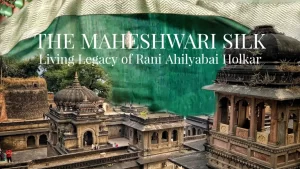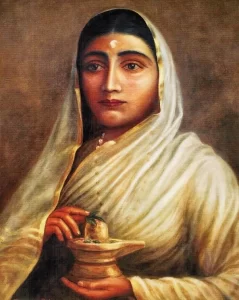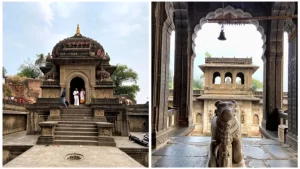 The history of Maheshwari sarees dates back to the 5th century. Maheshwar becomes a hub of Handloom weavers in 17th century and it had gained strength during the rule of Queen Ahilyabai Holkar and the first Maheshwari saree was designed by Rani herself and they were mostly used as Royal gifts for the royal guests. Ahilyabai was born in Chondi in 17th century, in spite of the culture of not educating a woman her father has provided her education and charm of being an only educated women of that time, she was praised by her father in law Malhar Rao Holkar, when he saw the bright future of Malwa in her eyes. As Joanna Baillie says
The history of Maheshwari sarees dates back to the 5th century. Maheshwar becomes a hub of Handloom weavers in 17th century and it had gained strength during the rule of Queen Ahilyabai Holkar and the first Maheshwari saree was designed by Rani herself and they were mostly used as Royal gifts for the royal guests. Ahilyabai was born in Chondi in 17th century, in spite of the culture of not educating a woman her father has provided her education and charm of being an only educated women of that time, she was praised by her father in law Malhar Rao Holkar, when he saw the bright future of Malwa in her eyes. As Joanna Baillie says

“In latter days from Brahma came,
To rule our land, a noble dame,
Kind was her heart and bright her fame,
Ahilya was her honored name, ”
– Joanna Baillie
Ahilyabai is regarded as one of the most visionary female rulers of India. She has established a textile industry in Maheshwar. She was an epitome of women empowerment much ahead of her times! The acclaim of inventing the Maheshwari sarees belongs to her. The charity of Ahilyabai in her own territory as well as throughout the country is well known. Charitable temples in her name Ghats and charitable buildings some are unnamed and some are named.
The most notable from Maheshwari handloom initiative is that people of this region are still economically independent specially women because of her initiative to weave Maheshwari saree in her town. During her rule she has invited weavers from other states to settle in Maheshwar and inspired them to replicate the intricate designs of the Fort on fabric that was the origin of Maheshwari Silk that is irreplaceable and celebrated till today.
Her immense contribution in renovation of numerous temples and dharamshalas throughout the country and weaving of Maheshwari saree is amongst the living Legacy of Queen Ahilya and the town has became the hub of Maheshwari handloom and it developed as the source of livelihood for majority of population of the Maheshwar town industries of Maheshwar have rhythmic sounds of handlooms weaving the fabric thread by thread in the houses of the town is a moment of pleasure and a soothing sound to hear. She has brought the intricately engraved patterns out of the town of Maheshwar such as the golden border, a fine texture that has flowing rivers and the images of the Forts of Maheshwar. The popular designs are Chameli Ka Phool that is a flower and brick pattern Heera that is also used to design on Maheshwari sarees and weaving patterns follow the sequence such as cotton threads on the horizontal and silk threads on the vertical. The borders are reversible.

The material that is used in these sarees is cotton and brought in from Coimbatore in South India. And processing of raw material was done in Kolkata and the saree was completed by the women of Maheshwar.
She promoted the trade of indigenous cloth in the state by all means and she had offered help to weavers particularly to set up their looms and weavers to settle in Maheshwar because of which Maheshwar silk got a vital price in the country and is famous hitherto. However, historians say for her that she has increased all within her realm and her kingdom to do their best during her rule. The merchants were producing the most beautiful clothes and trade during her period has flourished inevitably.

Under her rule Malwa has enjoyed peace, prosperity and stability and her capital Maheshwar had become a hub of literary, musical artistic and industrial pursuit’s even poets, artists, sculptors and scholars were also welcomed into the Kingdom. As Jawaharlal Nehru also says in his Discovery of India book in 1946-
“The reign of Ahilyabai, of Indore in Central India lasted for 30 years this has become almost legendary as a period during which perfect order and good government prevent and the people prospered she was the very able ruler and organizer highly respected during her lifetime and considered as Sant by a grateful people after her death.” (Jawaharlal Nehru (The Discovery of India/1946).
The Maheshwari sarees began losing their popularity during the time of independence but during that time the nonprofit organization such as Rehwa was created by Shivaji Rao Holkar to provide new life to the dying tradition. In economic terms Rehwa is playing a vital role in helping the women who produced the sarees. It constitutes 160 rivers and has a staff of 300 it employs almost 1500 lums so the total turnover generated by the organization is around 40-50 crore.
“Indore long mourned its noble Queen, happy had been her and her memory is cherished with deep reverence until this day.” writes Besant.

